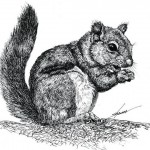 Recently, neighbors in a Lincoln County, Maine area are suing a woman for feeding wildlife. They have been trying to get her to stop feeding squirrels and chipmunks, because they say the wild animals she attracts to her home are getting into their homes and yards and causing costly damage. One neighbor is quoted as saying, “The chipmunks and the red squirrels are getting into my house and destroying my furniture every winter.” Others claim mice, rats and skunks are also attracted to the area, because of her efforts to feed wildlife.
Recently, neighbors in a Lincoln County, Maine area are suing a woman for feeding wildlife. They have been trying to get her to stop feeding squirrels and chipmunks, because they say the wild animals she attracts to her home are getting into their homes and yards and causing costly damage. One neighbor is quoted as saying, “The chipmunks and the red squirrels are getting into my house and destroying my furniture every winter.” Others claim mice, rats and skunks are also attracted to the area, because of her efforts to feed wildlife.
It’s easy to see both sides of this legal issue. Feeding birds, squirrels and chipmunks seems a perfectly normal and humane thing to do! It’s fun to watch squirrels chomping on seeds and nuts, or chipmunks stuffing their cheeks full of food. People like to watch these animals and don’t see the harm in helping them get through the winter.
On the other hand, deliberately attracting wildlife to your yard affects everyone around you. It can range from simple annoyance at cleaning up dropped seeds or nut shells to having squirrels nesting in your chimney, wall or attic because your neighbor likes to feed the squirrels. Squirrels can cause a great deal of costly damage to a home, chewing on electrical wiring, soiling and destroying insulation, infesting the area with mites or other bugs, and attracting further wildlife, like mice, rats, raccoons, skunks or snakes.
Most wildlife protection agencies agree that feeding wild animals can actually end up harming them, by making them less capable or willing to seek out their natural food sources. Their diets change, making them weaker or sick. And, they become less afraid of humans, which endangers both them and people.
